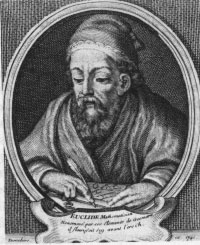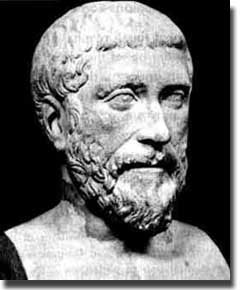
8.) Describe the contributions to geometry made by these mathematicians: Euclid, Archimedes, Mobius, and Pythagoras.
Euclid made many contributions to mathematics, many of which are still used today. For example, Euclid constructed a deductive system of Geometry, created of many theorems, some of which are still used as important aspects of modern mathematics. His most famous contribution, however, originated from his writings--the best known are his expositions, "The Elements." His writings are made mostly of the discoveries of earlier mathematicians, such as Hippocrates, Pythagoras, Thales, and Euxodus. His works began with definitions, "common notions," and axioms (postulates), followed by the proofs, basing each proof on the information before it.
Archimedes made his largest contributions to mathematics in the form of geometry. One of his most famous works is "Measurement of the Circle." In this, he determined the exact value of pi of being between 3 10/71 and 3 1/7. To determine this he circumscribed and inscribed a circle with regular polygons having 96 sides. This, however, did require the proof of 2 fundamental relations of the perimeters and areas of the inscribed and circumscribed regular polygons. He also proved that the volume of a sphere is 2/3 the volume of a cylinder that is circumscribed about the sphere. He also described how to trisect an angle using his spiral. First, construct circles of radii with a constant successive difference. These circles should cut the spiral at equal angles. In order to trisect a particular angle, trisect a radial line segment that corresponds to the value of the radii at the intersection of the spiral and the lines that create the angle (with the vertex at the origin). Finally, construct circles at the trisection points, centering them about the origin.
August Ferdinand Mobius published almost all of his work in Crelle's Journal, the very first journal fully devoted to publishing mathematical finds. In 1827, Mobius's work Der barycentrische Calcul, on analytical geometry, was a classic of his, including many of his results on projective and affine geometry. In this work, he introduces homogeneous coordinates and discusses geometric transformations, particularly projective transformations. He also introduced a configuration called the Mobius net, playing an important role in the development of projective geometry. Another of his introductions is the Mobius inversion formula, introduced in the paper Über eine besondere Art von Umkehrung der Reihen, in 1831. He also is recognized, yet not the founder, of the Mobius strip. (Listing was the first to discover and describe this object.) One last thing that I am going to mention is Mobius's publication of the geometric treatment of statics, which led to the study of systems of lines in space. Mobius, however, made many other contributions to the study of mathematics.
Pythagoras is considered an important contributor to the foundation of Greek geometry. One of Pythagoras's most famous discoveries is the Pythagorean Theorem, which is used to determine the sides of a right triangle (a^2 + b^2 = c^2). Pythagoras developed many theorems and proved them all, with the help of his followers, known as the Pythagoreans. He is also said to be the founder of the existence of irrational numbers. Pythagoras is also credited with the discovery of the fifth regular solid (polyhedron), the dodecahedron. A regular polyhedron is "a polyhedron that can be inscribed in or circumscribed about a sphere." This discovery required the discovery and proof of the regular pentagon. (The Pythagoreans are credited with the discovery of the fifth regular polyhedron due to this simple fact.) One final contribution that I will mention is the use of geometric algebra. Geometric algebra was created by applying areas to different equations. Geometric algebra was used to solve quadratic equations as modern algebra is used today. However, its complex nature prevented it from being utilized to solve more complicated polynomials.
Information and picture of Euclid were found at https://members.tripod.com/Turkler/euclid.html
Information and picture of Archimedes were found at http://www.math.tamu.edu/~don.allen/history/archimed/archimed.html
Information and picture of Mobius were found at
http://www-gap.dcs.st-and.ac.uk/~history/Mathematicians/Mobius.html
Information on Pythagoras was found at http://www.perseus.tufts.edu/GreekScience/Students/Mike/geometry.html
Picture of Pythagoras was found at
http://math-www.uni-paderborn.de/%7Erinkens/veranst/elgeo2001/kapitel1/img/Pythagoras_gross.jpg



